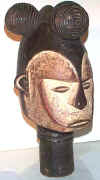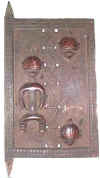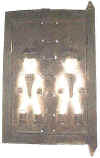





TRIBAL AFRICAN ART
IGBO (IBO)
Nigeria
Living mainly in the forested areas of south-west Nigeria, on both sides of the Niger River the Igbo number some ten million individuals. Mainly farmers and merchants, they also hunt and fish. They are subdivided into thirty-three subgroups and are spread out among about two hundred villages scattered through the thick forest or semifertile marshland. Only on the northern and western edges of the area, under influence from Igala and Benin, are hereditary rulers found. The heads of families form the council of elders, which shares its power with numerous secret societies. These societies exercise great political and social influence. They are highly hierarchical, their members passing from one level to the next. There is strong social pressure toward individual distinction, and men can move upward through successive grades by demonstrating their achievements and their generosity.
The lack of overall centralization among the Igbo-speaking peoples
has been conducive to the development of a great variety of art styles and cultural
practices. The earliest sculpture known from Igboland is from the village of Ibo Ukwu,
where the grave of a man of distinction and a ritual store, dating from the 9th century
AD, contained both chased copper objects and elaborate castings of leaded bronze. Ibo
sculpture is subject to rather strict rules: the figures are generally frontal,
symmetrical, and upright, with legs slightly spread, arms held away from the body, and
hands stretched forward, palms open. Proportions are true to those of the human body, with
the exception of the neck, which is more elongated. The whole gives the impression of
balance and stability yet lacks the degree of refinement and precision. The altar statues
called ikenga are sculpted from hard wood. They include a pair of horns, identified
as the horns of a ram who “fights with his head” – hence is symbolic of
aggression and perseverance. Since the ram rarely fights, he therefore symbolizes
self-control and determination to the Igbo. The statue is scarified to reflect the status
of its owner. Young men acquire an ikenga at various ages, but they all own one of
them by the time they get married and settle down. The large ikenga belong to whole
communities, age groups, or lineages. They are characterized by complex hairdos, which,
again, use the theme of horns. These statues are displayed during ceremonies and
strengthen the sense of community solidarity. The
alusi figures are the protective divinities associated with elements of nature (the
rivers, the earth) or social elements (markets, ancestors). They are gathered in
sanctuaries on the model of familial Igbo groups, and – in the hairstyles, the
scarring, and the ornaments – they present the status symbols of influential people.
There is a recurrent element in the palms of the hands, turned one to the other to
indicate frankness, the openness to giving and receiving, the relationship of reciprocity
that exists between men and gods.
The Igbo use thousands of masks, which incarnate unspecified spirits of the dead, forming a vast community of souls. The outstanding characteristic of the many Igbo masks is that they are painted chalk white, the color of the spirit. Masked dancers wore extremely elaborate costumes (sometimes ornamented with mirrors) and often their feet and hands were covered. With their masks, the Igbo oppose beauty to bestiality, the feminine to the masculine, black to white. The masks, of wood or fabric, are employed in a variety of dramas: social satires, sacred rituals (for ancestors and invocation of the gods), initiation, second burials, and public festivals, which now include Christmas and Independence Day. Some masks appear at only one festival, but the majority appear at many or all. Best known are those of the Northern Ibo mmo society, which represent the spirits of deceased maidens and their mothers with masks symbolizing beauty. Among the Southern Ibo, the ekpe society, introduced from the Cross River area, uses contrasting masks to represent the maiden spirit and the elephant spirit, the latter representing ugliness and aggression and the former representing beauty and peacefulness. A similar contrast is found in their okorosia masks, which correspond to the mmo of the Northern Ibo. The Eastern Ibo are best known for masquerades associated with the harvest festival, in which the forms of the masks are determined by tradition, though the content of the play varies from year to year. Stock characters include Mbeke, the European; Mkpi, the he-goat; and Mba, which appear in pairs, one representing a boy dressed as a girl mimicking the behavior of a girl, the other representing the girl being satirized.
A great many other decorative wooden objects are made, including musical instruments, doors, stools, mirror frames, trays for offering kola nuts to guests, dolls, and a variety of small figures used in divination.
 |
||||
 |
 |
 |
 |
 |